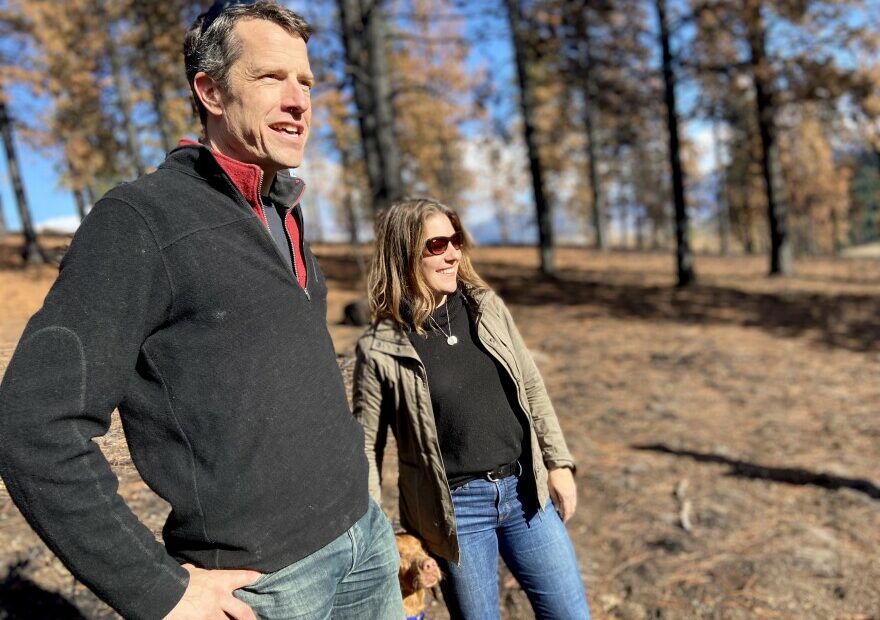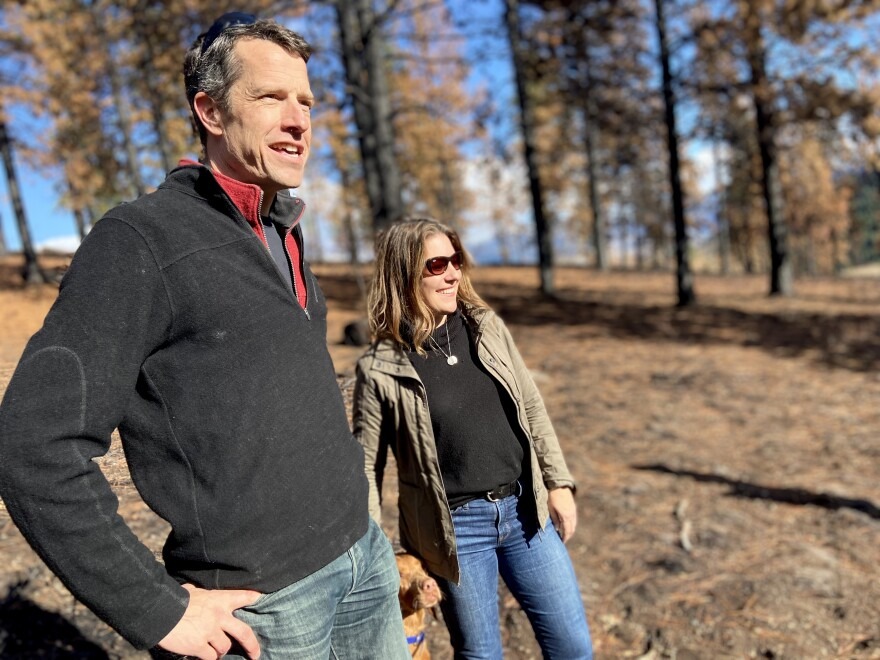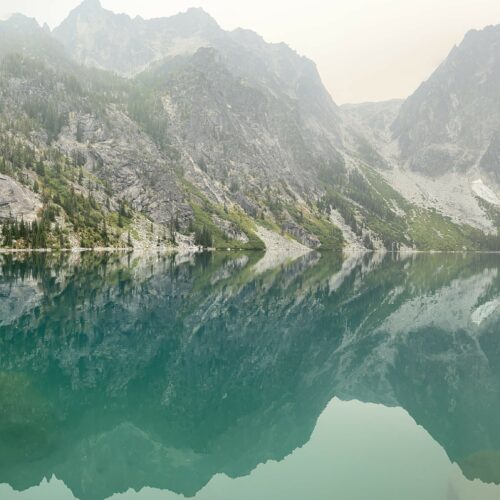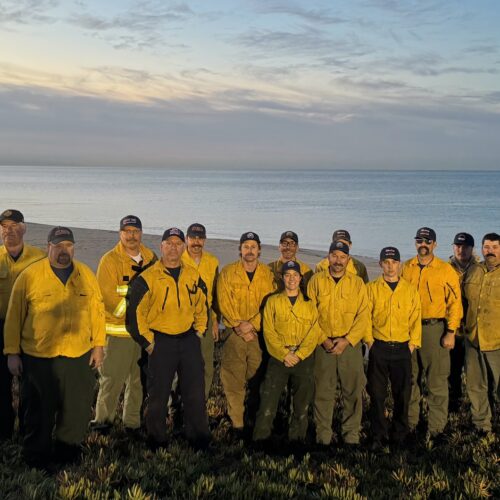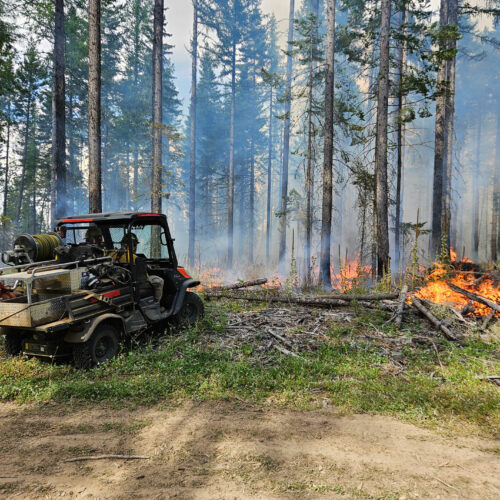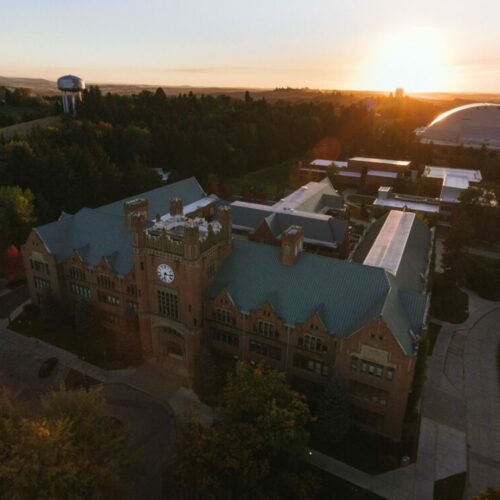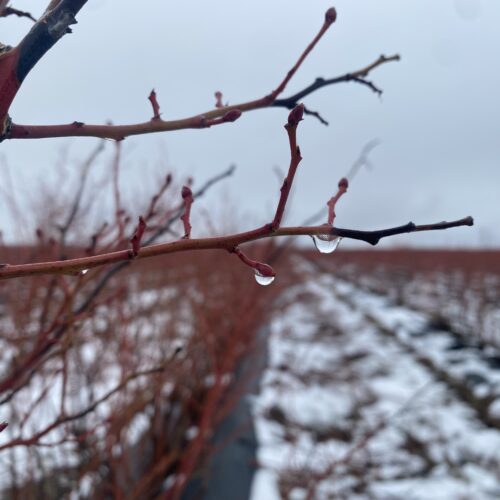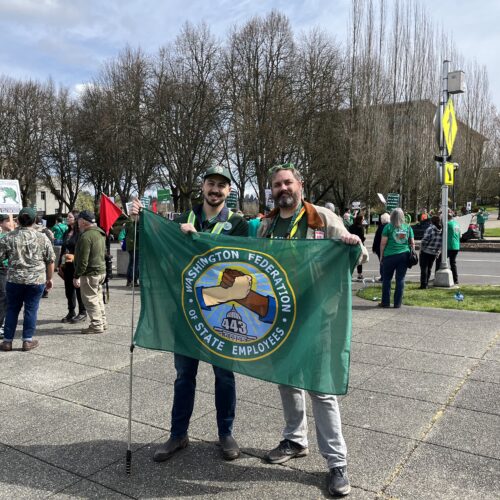Peter Polson’s feet crunch as he walks across a meadow on his property. This time last year, his boots wouldn’t have made that noise. Now, the meadow is blackened after the Cedar Creek fire swept through his land just west of downtown Winthrop.
The fire pushed its way down his hillside, consuming ponderosa pine bark, bitterbrush and aspen stands in its wake. The flames destroyed a 120-year-old settler’s cabin – even a cast iron wood stove crumbled under the heat.
“It was so beautiful,” said Shannon Polson. “I loved it.”
“Yeah, that was one of Shannon’s favorite parts of the settler’s cabin,” Peter Polson said, as he dropped a chunk of the crumbled stove to the ground.
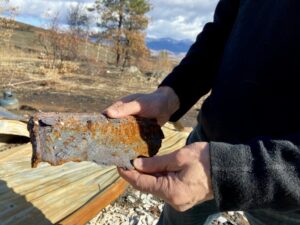
Peter Polson holds a piece of a wood stove that burned, along with a 120-year-old settler’s cabin, in the Cedar Creek fire. CREDIT: Courtney Flatt
The destruction from the fire could have been much worse.
Of the five nearby structures, including the Polson family’s newly built home, a barn, and neighboring houses, only the settler’s cabin faced the flames.
That’s thanks to a little bit of luck and a lot of determination. For six years, the family worked nights, weekends and holidays. They thinned trees, chopped off limbs, and built a home resistant to fire to prepare their property for when the flames would come.
They knew the clock was ticking.
“Fires are like hurricanes – it’s not if but when. You’ll see fire here in your lifetime. And if you prepare for it, you can keep it to a low intensity,” Peter Polson said of advice he heard when he first moved to the area.
Their time ran out this past summer.
Lighting sparked a fire on the Okanogan-Wenatchee National Forest on July 13, a little more than 10 miles from their home. A week later, crews alerted the Polsons that the fire was headed their way.
Peter Polson began his final preparations. He mowed tall grass that had grown up around 20 feet from their home. They ripped out a final pile of bitterbrush underneath a clump of ponderosa pines close to their house, Shannon Polson said.
“The bitter brush burns hot,” Shannon Polson said. “I don’t know what would have happened with those trees if that had still been there.’
That last push of landscaping was the culmination of the family’s hard work to save their home and protect as much habitat as possible.
Their hard work began nearly six years ago, a year after the infamous Carlton Complex burned through North Central Washington’s Methow Valley and into the towns of Pateros and Brewster. Today, the Carlton Complex still stands as the largest fire in Washington state history.
The Polsons moved to the Methow Valley one week before the Carlton Complex ignited in 2014, forever coloring their opinions about their property and the fire hazards on it.
“The Carlton Complex put, not the fear of God, but the fear of fire in everyone here,” Shannon Polson said.
It’s almost like PTSD, she said.
“Not just from Carlton but what has happened since. Ever since we’ve moved here, there’s been major, major fire events,” Shannon Polson said.
The next summer in 2015, Ken Bevis, Department of Natural Resources stewardship wildlife biologist, visited the Polsons.
Bevis, whose home very nearly burned down in the Carlton Complex, told the Polsons in no uncertain terms that they had a lot of work to do to prepare for when their time would come.
Bevis recommended the family use fire-resistant materials when they built their new home. He also worried about all the small trees that had grown up underneath the ponderosa pines. Those smaller trees could help flames reach the crowns of the larger trees, which would mean more trees would die.
Of his concerns, Bevis said he saw lots of small trees near where the Polsons planned to build. He noted lots of fine fuels that would burn.
He pointed to each hazard, cementing the family’s healthy fear of fire, Shannon Polson said.
Bevis convinced the family that to save their trees, they had to cut some down.
That advice translated into more than 20 removed trees and untold number of low-hanging branches chopped. Fires can climb up low branches and light fuels on the ground, which helps flames reach the tops of trees. Aptly, these hazards are named ladder fuels.
Peter Polson’s 6.5-foot frame helped reach high up in the branches. His friends also helped out, joining him on long weekends to shear limbs.
Every time he said he’d thought he’d done enough, another fire would burn through the Methow Valley.
“You look around and you’re like, well, I think we could trim those trees a little bit higher, and I think we could do a little more work,” he said.
Every year, they’d thin a little more, remove a few more limbs.
The Polsons gave away some logs to local mills and used others for firewood. Some of the largest trees remain on the ground. The rest of the slash, they burned.
Two years ago on Easter weekend, Peter Polson stayed up all night burning 21 brush piles. The weather window was good, raining all night. It looked like the last time they could rid the ground of the debris, which could light up like matchsticks if a wildfire got to it first.
“We just kept lighting one after, after another until the sun rose in the morning,” Peter Polson said.
Burning slash piles is challenging, he said. Timing the burns is tricky. Burns require good weather and an awareness of what’s going on at all times so that the burns don’t get out of control.
According to the Department of Natural Resources, around 17% of fires in Washington start when flames escape a property owner’s burn piles.
Peter Polson said, “I don’t think I’ve ever burned a brush pile without at one point feeling a little on edge about what might happen.”
Burning slash piles can also be challenging for the professionals.
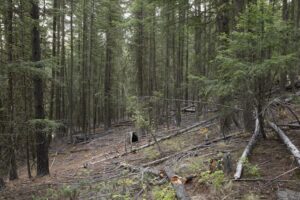
A forest stand in the Virginia Ridge area before it was harvested. CREDIT: John F Marshall
The Department of Natural Resources manages around 1,280 acres near the Polson’s property. In 2019, the department thinned trees at Virginian Ridge.
That thinning helped some of the trees survive, said Jake Hardt, landowner assistance forester with the Department of Natural Resources. During the summers, Hardt works as a self-proclaimed dirtbag firefighter.
Thinning also helped contain the fire and protect communities, Department of Natural Resources officials said.
However, piles of wood stacked to the size of homes stayed on the Virginian Ridge property to dry out. Large slash piles are common for industrial thinning sites where whole trees are cut down, Hardt said.
“That way that debris is in one location not spread on the landscape,” Hardt said. “That larger pile takes a long time to dry to where it’s going to burn efficiently and not just smoke everybody out.”
Typically, slash piles are left to dry for one to three years, said Derek Churchill, forest health scientist with the Department of Natural Resources. The timing of the fire was just unlucky, he said.
“I think what we’re seeing with climate change is that the probability of fire is going up and there’s drier conditions,” Churchill said.
They may have to work faster to stay ahead of climate change, Churchill said.
Hardt said leaving piles beyond three years is much too long.
Moreover, said Mike Liu, Okanogan Forest lead with Conservation Northwest, based in Twisp, the extra wood on the forest ground likely accelerated the fire in some places.
Studies show the best way to make a forest resilient to fire is to follow up thinning with prescribed burns, Liu said.
It’s easier to control and stop fires if areas are thinned and burned, Liu said.
In addition, Liu said, treating areas larger than Virginian Ridge would better reduce wildfire risks. However, that’s going to require communities to tolerate smoke outside of wildfire season, which can be a tough ask, he said.
Department officials said in an earlier interview they plan to thin and burn at least 70,000 acres of forest each year over the next 20 years.
For the Polsons, the final step of burning on the public land didn’t happen soon enough. Living next door to the large slash piles was scary, Shannon Polson said.
“Many burn seasons have gone by and they’re still there,” she said. “So that’s frustrating for all of us who are in the path.”
The slash piles made the fire worse, Peter Polson said.
“Not all of them burned because some of them are outside the fire perimeter, and I hope those will be burned this winter,” he said.
In the summer, the slash piles that burned pushed the fire toward the Polson family home, which they evacuated the week before the flames burned through their land.
As they drove away, Peter Polson said, “I just felt like we’ve done our best with this area. There’s always second guessing, but I felt reasonably comfortable.”
They watched from a webcam as firefighters pulled back because of dangerous weather conditions. Shortly after that, Okanogan County Electric Co-op cut the power to their home.
All they could do was wait and hope they had done enough.
They had.
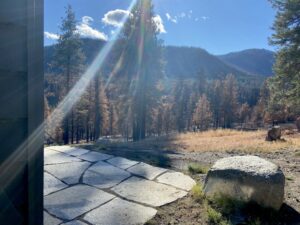
Flames from the Cedar Creek fire came within 20 feet of the Polson family’s home. CREDIT: Courtney Flatt
Nearly three months later, looking at the larger burned landscape is difficult, Shannon Polson said. However, she said she’s proud of how most of their land fared.
The goal, the Polsons said, was to keep the house standing and not to live in a moonscape post-fire. They wanted the mature ponderosa pine trees to survive.
“We know those weren’t going to grow back in our lifetime,” Peter Polson said.
“Many of them will survive,” Bevis replied as he looked around the property.
Two burned aspen stands will grow back strong as well, Bevis predicted.
Next spring could bring fields of lupine. Morel mushrooms also could sprout up. The birds will return, he said.
Flames didn’t reach the Polson’s house, which they built out of fire-resistant hardie board siding instead of the wood they’d initially dreamed up.
“Just imagine someone’s taking a match, lighting it and flicking them against your house. If your house could survive that, your house is in better shape for embers,” Peter Polson said of advice Bevis gave them before building their home.
The family also surrounded their home with what Shannon Polson called a hard-landscape: gravel three-feet around every edge of the home, no nearby trees.
Gravel is one of the best, most inexpensive ways to begin preparing your home for wildfires, Hardt said.
Okanogan County hasn’t adopted building codes for people living on the edge of the forests, known as the wildland-urban interface. Those types of codes could do a great deal to protect homes, he said.
Hardt helps landowners assess their property and get access to cost-sharing programs, although the Polsons did most of the work on their own.
From April through the start of June this year, around 1,200 people requested consultations through the state’s Wildfire Ready Neighbors program. According to the Department of Natural Resources, 454 people in Okanogan County asked for surveys of their land.
Sometimes the property surveys could mean people need to thin more trees than they hoped, Hardt said.
“They called me because they knew they had to do something,” Hardt said. “Then I tell them they have to take 50% of their trees out. That’s a hard pill to swallow when they moved here to live in their trees.”
And, after this summer, Shannon Polson said she would love to remove even more trees. She said she feels responsible for this land.
Since moving to the Methow Valley, she said her opinions on a beautiful forest have completely turned around. At first, she didn’t want to cut any trees densely packed together. Now, she’d like her land to be even more open.
“I think it’s just as beautiful if your trees didn’t burn. That means that we’ve got to thin them,” she said. “I think it’s absolutely gorgeous to have a thinner, healthy forest.”

